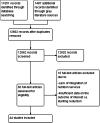Best practices and opportunities for integrating nutrition specific into nutrition sensitive interventions in fragile contexts: a systematic review
- PMID: 34321101
- PMCID: PMC8320180
- DOI: 10.1186/s40795-021-00443-1
Best practices and opportunities for integrating nutrition specific into nutrition sensitive interventions in fragile contexts: a systematic review
Abstract
Background: Annually, undernutrition contributes globally to 45% (3.1 million) of preventable deaths in children under 5. Effect following undernutrition i.e. physical growth & cognitive development etc. can be prevented during the first 1000 days also called window of opportunity. There is substantial evidence of positive nutrition outcomes resulting from integrating nutrition-specific interventions into nutrition specific program. However, there is paucity of knowledge on establishing and sustaining effective integration of nutrition intervention in fragile context. The objective of this review is to map and review the integration of nutrition-specific intervention to nutrition sensitive program and its impacts on nutrition outcomes.
Methods: In the study, we systematically searched the literature on integrated nutrition intervention into multi-sectoral programme in PUBMED, Google's Scholar, the Cochrane Library, World Health Organisation (WHO), United Nations Children's Fund (UNICEF), World Bank and trial registers from their inception until Oct 30, 2020 for up-to-date published and grey resources. We screened records, extracted data, and assessed risk of bias in duplicates. This study is registered with PROSPERO (CRD42020209730).
Result: Forty-four studies were included in this review, outlining the integration of nutrition-specific interventions among children 0-59 months with various existing programme. Most common integration platform in the study included integrated community case management and Integrated Management of Childhood Illness, Child Health Days, immunization, early child development, and cash transfers. Limited quantitative data were suggestive of some positive impact on nutrition and non-nutrition outcomes with a number of model of integration which varies according to the context and demands of the particular setting in which integration occurs.
Conclusion: Overall, existing evidence for nutrition sensitive and specific interventions is not robust and remains limited. It's worthwhile to note, for future studies/interventions should be based on the context key criteria like relevance, political support, effectiveness, feasibility, expected contribution to health system strengthening, local capacities, ease of integration and targeting for sustainability, cost effectiveness and financial availability.
Keywords: Integration; Multi-sectoral programme; Nutrition outcome; Nutrition sensitive; Nutrition specific.
© 2021. The Author(s).
Conflict of interest statement
None.
Figures








Similar articles
-
Integrating nutrition into health systems: What the evidence advocates.Matern Child Nutr. 2019 Jan;15 Suppl 1(Suppl 1):e12738. doi: 10.1111/mcn.12738. Matern Child Nutr. 2019. PMID: 30748112 Free PMC article. Review.
-
How has the impact of 'care pathway technologies' on service integration in stroke care been measured and what is the strength of the evidence to support their effectiveness in this respect?Int J Evid Based Healthc. 2008 Mar;6(1):78-110. doi: 10.1111/j.1744-1609.2007.00098.x. Int J Evid Based Healthc. 2008. PMID: 21631815
-
The Effectiveness of Integrated Care Pathways for Adults and Children in Health Care Settings: A Systematic Review.JBI Libr Syst Rev. 2009;7(3):80-129. doi: 10.11124/01938924-200907030-00001. JBI Libr Syst Rev. 2009. PMID: 27820426
-
Promoting and supporting self-management for adults living in the community with physical chronic illness: A systematic review of the effectiveness and meaningfulness of the patient-practitioner encounter.JBI Libr Syst Rev. 2009;7(13):492-582. doi: 10.11124/01938924-200907130-00001. JBI Libr Syst Rev. 2009. PMID: 27819974
-
Community interventions in Low-And Middle-Income Countries to inform COVID-19 control implementation decisions in Kenya: A rapid systematic review.PLoS One. 2020 Dec 8;15(12):e0242403. doi: 10.1371/journal.pone.0242403. eCollection 2020. PLoS One. 2020. PMID: 33290402 Free PMC article.
Cited by
-
A Qualitative Exploration on Perceived Socio-Cultural Factors Contributing to Undernutrition Among Under-Fives in the Southern Highlands of Tanzania.Int J Public Health. 2023 Jul 21;68:1605294. doi: 10.3389/ijph.2023.1605294. eCollection 2023. Int J Public Health. 2023. PMID: 37546349 Free PMC article.
-
Effect of integrated nutrition-sensitive and nutrition-specific intervention package on maternal malnutrition among pregnant women in Rwanda.Matern Child Nutr. 2022 Jul;18(3):e13367. doi: 10.1111/mcn.13367. Epub 2022 May 10. Matern Child Nutr. 2022. PMID: 35538044 Free PMC article.
-
Lessons learned from operationalizing the integration of nutrition-specific and nutrition-sensitive interventions in rural Ethiopia.PLoS One. 2025 Apr 2;20(4):e0290524. doi: 10.1371/journal.pone.0290524. eCollection 2025. PLoS One. 2025. PMID: 40173174 Free PMC article.
-
Outpatient treatment of children with severe acute malnutrition within the health care system in a humanitarian crisis: a cross-sectional study in Uganda during the Horn of Africa drought response.BMC Nutr. 2025 Jul 4;11(1):126. doi: 10.1186/s40795-025-01113-2. BMC Nutr. 2025. PMID: 40616117 Free PMC article.
-
Utilising emerging perspectives at the global and regional level to frame multisectoral nutrition governance landscape in Kenya.Public Health Nutr. 2024 Mar 20;27(1):e99. doi: 10.1017/S1368980024000727. Public Health Nutr. 2024. PMID: 38504549 Free PMC article. Review.
References
-
- World Health Organization . WHO Global Database on Child Growth and Malnutrition. Geneva: WHO; 2019.
-
- World Health Organization Study Group on Integration of Health Care Delivery . Integration of health care delivery. Geneva: WHO; 1996.
LinkOut - more resources
Full Text Sources
